Detailed data and statistics indicating trends in birdwatching across the United States.
Have you ever wanted to know more about birdwatching enthusiasts? I conducted a survey to find out more about the people who participate in this popular hobby across the U.S. I asked 560 birdwatchers questions about why they do it, when and why they started, why they continue, how old they are, how much they spend on it, whether they go on birdwatching trips, what they like to do besides watching birds, and more.
I also learned about the challenges they face and how birdwatching makes them feel.
In this article, I’ll share the exciting things the survey revealed.
Key Takeaways from this Survey
- 95% of birdwatchers emphasized the significant importance of birdwatching for relaxation and stress relief.
- 87% of birdwatchers spend about $100 – $499 annually on their wild bird hobby.
- 81% of birdwatchers were inspired to begin birdwatching due to their personal love of birds or nature (vs being introduced by a family or friend).
- 79% of birdwatchers are female.
- 77% of birdwatchers have never participated in any citizen science.
- 77% of birdwatchers are 55 or older.
- 73% of birdwatchers have never gone on a birdwatching trip.
- 72% of birdwatchers also enjoy gardening as a hobby.
- 44% of birdwatchers have a household income of $25,000 – $74,999.
- 35% of birdwatchers observe birds exclusively in their yards.
- 30% of birdwatchers that are 55+ started birdwatching when they were 25 or younger.
About This Survey
I surveyed 560 birdwatchers to learn more about them.
My aim was to gather insights into their behaviors, preferences, motivations, and patterns of birdwatching. I also wanted to explore their awareness of environmental conservation.
By learning these factors, we can tailor our efforts to encourage more individuals, including new generations, to participate in birdwatching and become advocates for the protection of wild birds, nature, and the planet as a whole.
Why is birdwatching so popular?
Q: How important is birdwatching to you in terms of relaxation and stress relief?
Based on the survey results, it’s evident that birdwatching is regarded as a significant source of relaxation and stress relief for the majority of participants:
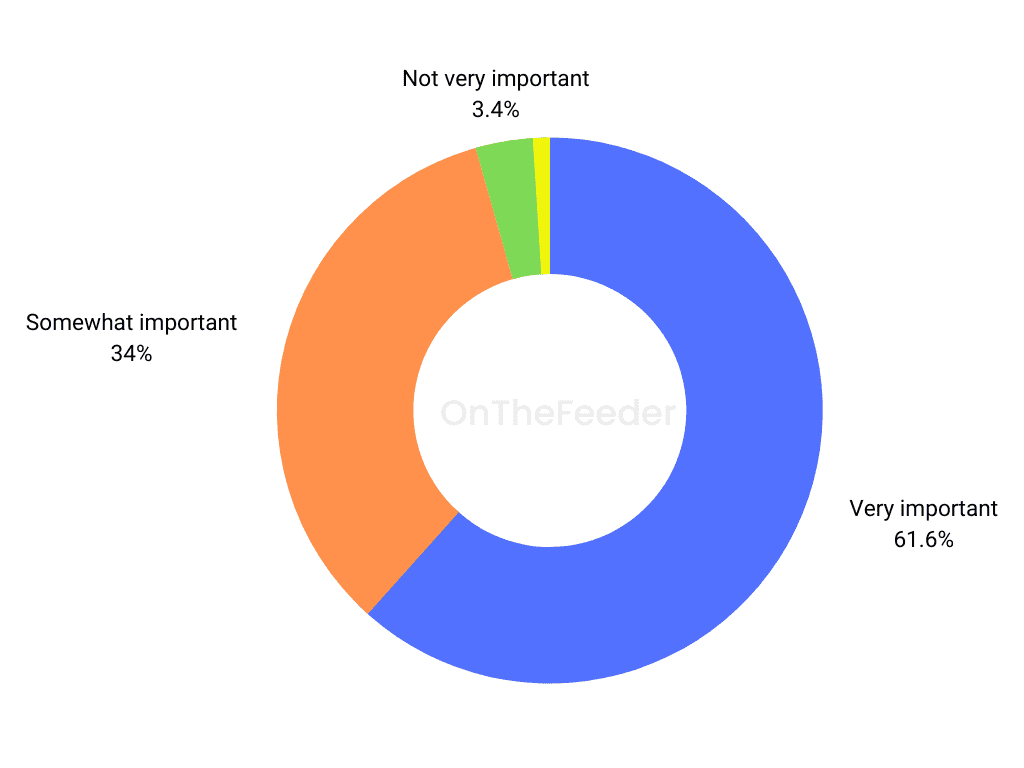
- Primary Importance of Birdwatching for Relaxation and Stress Relief: Over 60% of respondents consider birdwatching to be very important for relaxation and stress relief. This emphasizes the significant role birdwatching can play in helping individuals maintain their mental health and overall well-being.
- Widespread Agreement on Birdwatching’s Benefits: When adding those who found it somewhat important, a resounding 95.9% of respondents see birdwatching as a source of relaxation and stress relief to some degree. This nearly unanimous agreement suggests a widely recognized therapeutic value in birdwatching.
- Birdwatching as a Wellness Activity: These insights could position birdwatching as a potential wellness or therapeutic activity, appealing not only to bird lovers or nature enthusiasts but also to those seeking effective ways to relax and alleviate stress.
- Future Promotion of Birdwatching: This information could be helpful for promoting birdwatching to a wider audience, as an accessible and enjoyable way to improve mental health and reduce stress.
How much money is spent on birdwatching?
Birdwatchers mostly spend between $50 and $499 a year on their hobby, but some spend less than $50, and a few spend over $500. This shows there are both casual and serious birdwatchers.

- Lower-end Spending: A small but substantial group of birdwatchers (19.9%) reported spending less than $50 annually on birdwatching supplies, suggesting that a portion of the community maintains their hobby on a tighter budget and underscores the inexpensive nature of it.
- Mid-range Spending: The bulk of respondents fell into mid-range spending categories. Specifically, 17.9% spent between $50 and $99, while 23.6% allocated $100 to $199, and 26.2% expended $200 to $499. This demonstrates that a large portion of birdwatchers are willing to invest a moderate amount in their hobby.
- Higher-end Spending: Interestingly, a smaller but significant group (12.2%) reported spending $500 or more annually on birdwatching supplies, indicating a segment of birdwatchers who are highly invested in the hobby and possibly pursuing it at a more advanced or intensive level.
Is bird watching a cheap hobby?
Almost 20% of birdwatchers spend less than $50 per year on the hobby making it a relatively cheap pastime.
What are the demographics of birdwatching?
The demographics of birdwatching include females approximately 55 years old and older. This group also tends to enjoy at least one additional nature-focused activity including gardening, photography, hiking, and traveling.
Inspiration for Birdwatching
Q: What inspired you to become a backyard birdwatcher?
Here are some observations regarding what motivates individuals to take up backyard birdwatching:
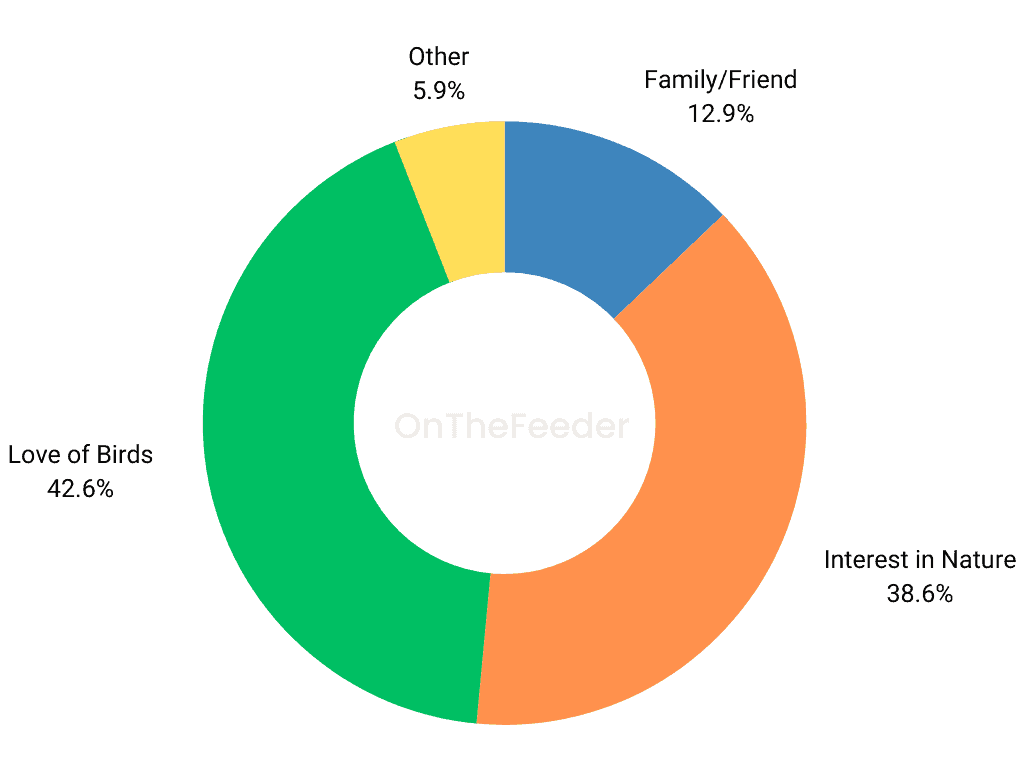
- 43% of the respondents expressed their love of birds as the driving factor behind their decision to become backyard birdwatchers. This suggests that the appeal and fascination with birds specifically had a strong influence on their interest in this hobby.
- 39% of birdwatchers cite their own personal interest in nature as the main inspiration for becoming backyard birdwatchers. This indicates that a majority of participants were inherently drawn to nature and likely sought out activities that allowed them to engage with and appreciate the natural world.
- 13% of the birdwatchers mentioned that they were inspired by a family member or friend. This tells us that having someone close to you who already enjoys birdwatching can be a significant influence and motivation to start this hobby. It highlights the importance of sharing our passions and experiences with others, as it can inspire them to develop an interest in birdwatching and contribute to the preservation of birds and nature.
Gender
Here are some glaring numbers about the gender who favors birdwatching:
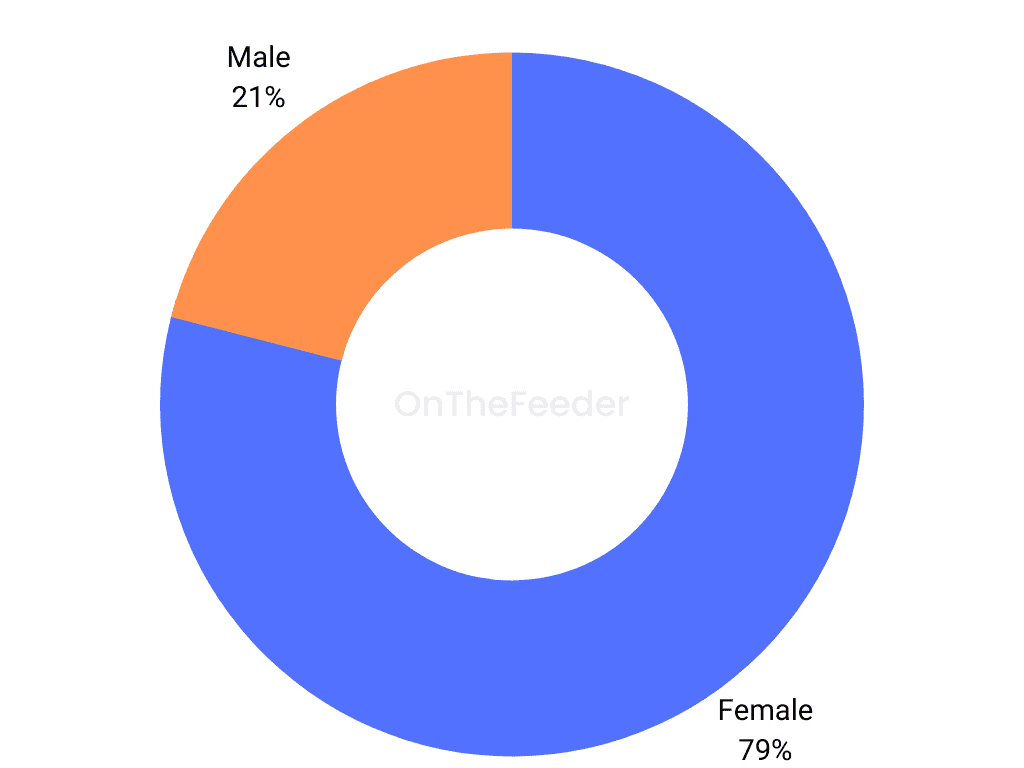
- Potential gender-specific perspectives: The stark gender disparity in birdwatching participation (79% female vs 21% male) raises intriguing questions about potential gender-specific perspectives and motivations related to birdwatching. Exploring the underlying factors contributing to this gender distribution could uncover unique interests, preferences, or connections women have with birds and nature, contributing to a deeper understanding of the diverse experiences within the birdwatching community.
- Opportunities for gender-focused outreach and engagement: The stark contrast in gender representation within the birdwatching community presents an opportunity for targeted outreach and engagement efforts. Recognizing the higher proportion of women involved in birdwatching, initiatives can be developed to specifically encourage and support the participation of men in the hobby.
Citizen Science Participation
Q: Have you ever participated in any citizen science projects related to birdwatching?
Based on the survey results, a significant majority of birdwatchers are not actively participating in citizen science projects, indicating a potential opportunity for increased involvement and engagement in scientific data collection and conservation efforts within the birdwatching community.
Citizen science is scientific research conducted with participation from the general public.
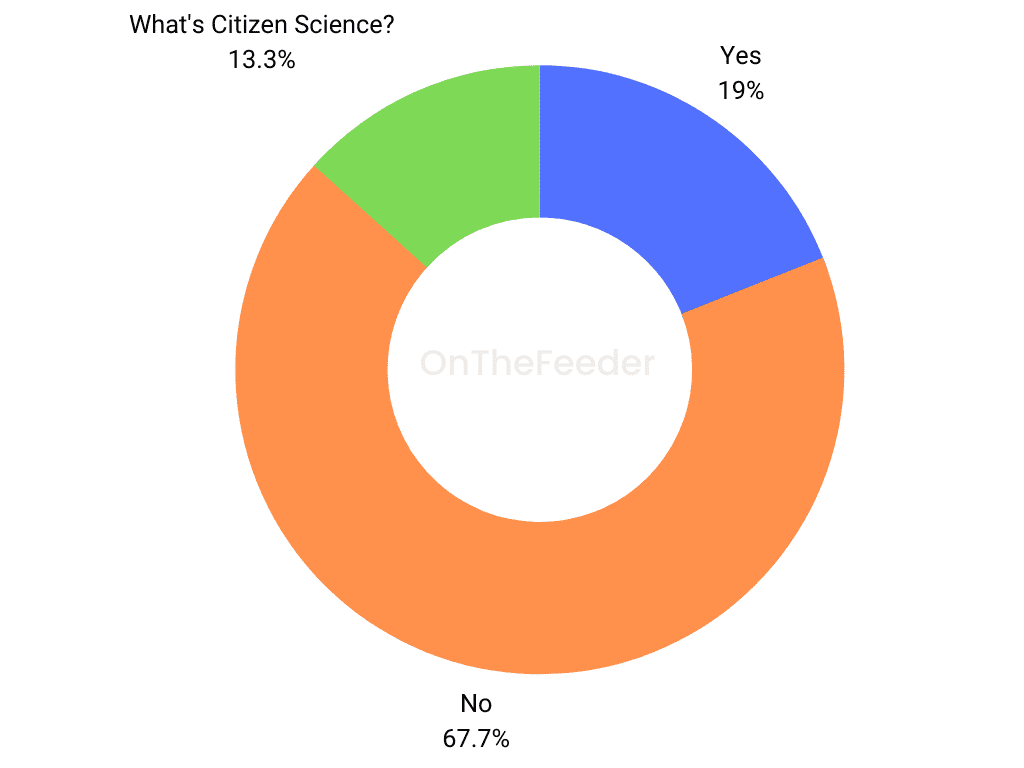
- Primary Engagement in Citizen Science: 19% of respondents reported participating in these activities, highlighting that a minority of birdwatchers are directly contributing to scientific knowledge in ornithology.
- Low Participation in Citizen Science: Conversely, 67% of respondents have not participated in any citizen science initiatives. This suggests that while birdwatching is popular, a considerable majority of its enthusiasts are not actively involved in helping the research side.
- Unawareness of Citizen Science: Among those who have not participated, 13% reported they had never heard of citizen science. This reveals an area where education and outreach could be improved.
- Promoting Citizen Science: These insights could be useful in formulating strategies to increase awareness and participation in citizen science among birdwatchers. The promotion could emphasize the potential for birdwatchers to contribute to scientific knowledge, thus adding another rewarding dimension to their hobby.
Age of Birdwatchers
Here are some not-so-surprising insights into the ages of birdwatchers:
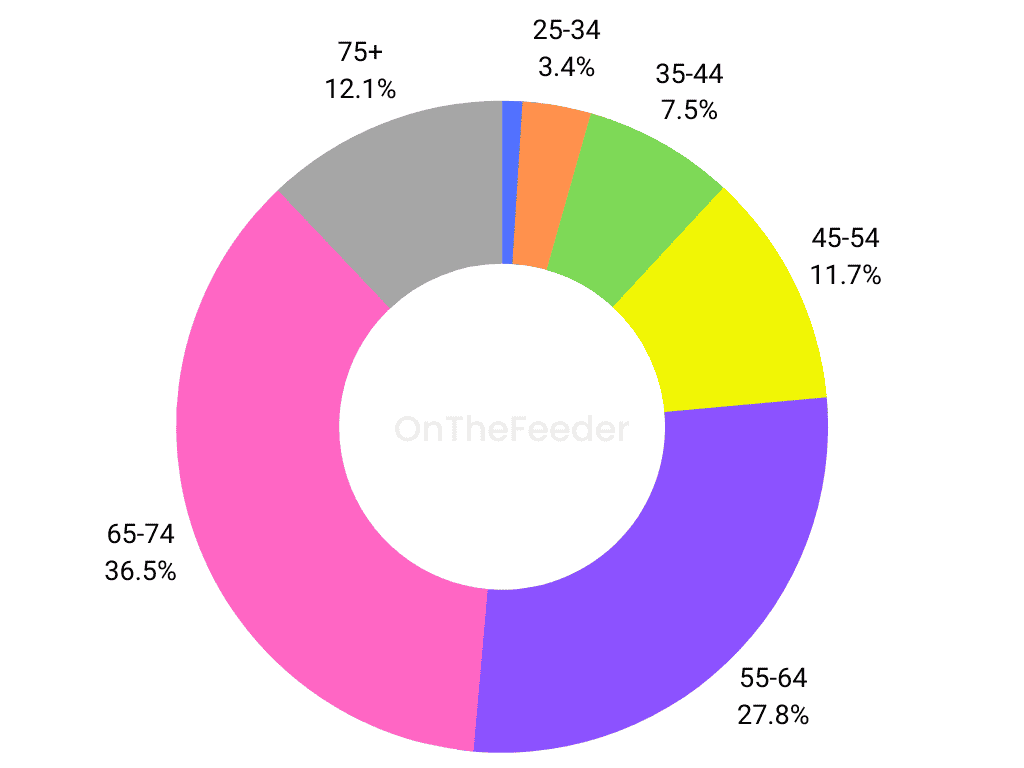
- Birdwatching primarily attracts older individuals: The majority of birdwatchers are in the age range of 55 or older. Specifically, 76.5% of birdwatchers are between the ages of 55-74, and an additional 12.1% are 75 or older. This suggests that birdwatching is particularly appealing to retirees or those nearing retirement, possibly due to the leisure time, relaxation, and connection with nature that this hobby provides.
- Younger age groups are less involved in birdwatching: Less than 4% of birdwatchers are under the age of 35, and only 11% are between the ages of 25-44. This might indicate that younger people have less time for birdwatching.
- Birdwatching seems to increase with age: There seems to be a trend where the proportion of birdwatchers increases with age. This might suggest that people gain more time and opportunity for birdwatching as they get older.
What is the Average age of birdwatchers
The average age of birdwatchers is 59.
I intentionally asked the survey respondents what their approximate age was, from a range of ages. I felt this would offer the release resistance in providing an answer. It also made calculating the average age a bit more challenging – but not impossible.
Here’s how I calculated the average age:
- Calculated an approximate average age based on the midpoint of each age range.
- Multiplied the midpoint of each range by the total respondents in that age range.
- Divided the sum of the total number of respondents.
- Voila! 59
Birdwatching Trips
Q: Have you ever gone on a birdwatching trip? If so, where did you go?
Birdwatchers were asked about their tendency to go on birdwatching trips and where to. The insights from their responses:
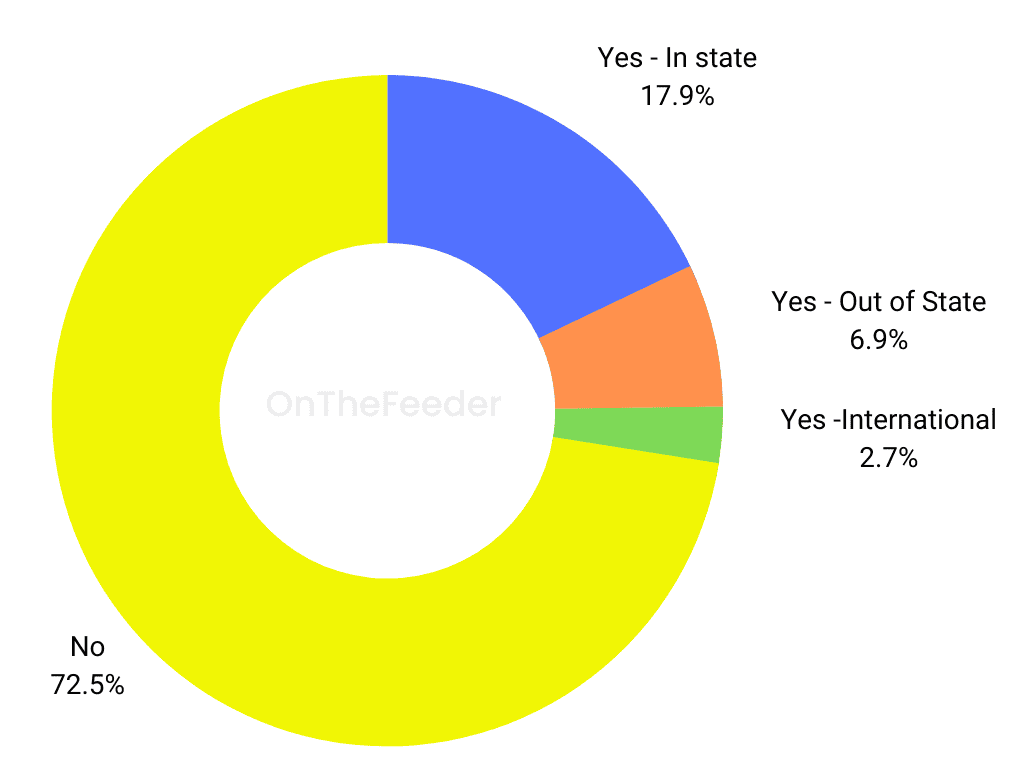
- The majority of birdwatchers don’t travel for birdwatching: Most respondents (72.4%) have not gone on a birdwatching trip, suggesting that birdwatching might be a primarily local activity for most individuals.
- Birdwatching within the home state is more common than interstate or international trips: A significant minority (17.9%) of birdwatchers have gone on trips within their own state. This indicates that some birdwatchers are willing to travel, but possibly prefer staying relatively close to home.
- Interstate and international birdwatching trips are less popular: Only a small percentage of birdwatchers travel beyond their home state for this activity. Just 7.0% go to other states, and an even smaller number (2.7%) travel internationally for birdwatching. This could suggest that long-distance travel for birdwatching is either less appealing, not feasible, or simply less common for most birdwatchers.
- Local birdwatching opportunities and awareness could be enhanced: Given that a majority of birdwatchers do not travel for the activity, there could be an opportunity to improve local birdwatching resources or raise awareness about local birdwatching opportunities.
Other Hobbies
Q: What other hobbies or interests do you have besides birdwatching? Select all that apply.*
- Gardening
- Photography
- Hiking
- Cooking
- Reading
- Traveling
- Other
The survey results provide insights into the wide array of hobbies and interests birdwatchers engage in apart from their feathered friends. Here’s how they responded:
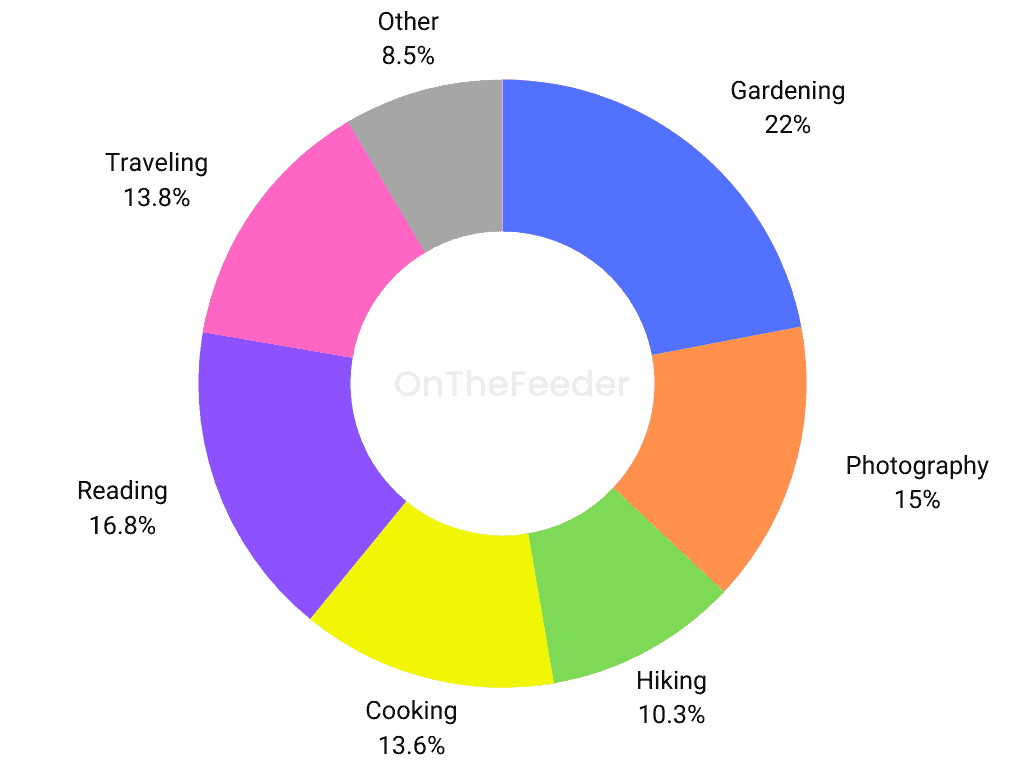
- The dominance of Gardening: The clear frontrunner among the suggested hobbies is gardening, with 22% of respondents partaking in it. This strong correlation is understandable considering the shared theme of nature appreciation in both gardening and birdwatching.
- The popularity of Other Hobbies: Photography (15%), hiking (10.3%), cooking (13.6%), reading (16.8%), and traveling (13.8%) were other hobbies frequently mentioned. Each one, to varying degrees, reflects diverse interests beyond birdwatching within this community.
These findings demonstrate the multifaceted interests of birdwatchers, with a notable lean towards nature-based hobbies. This understanding could help in crafting more engaging communication and outreach strategies that touch on these overlapping interests.
Household Income
The survey inquired about the birdwatchers’ household income. Here’s how they responded:
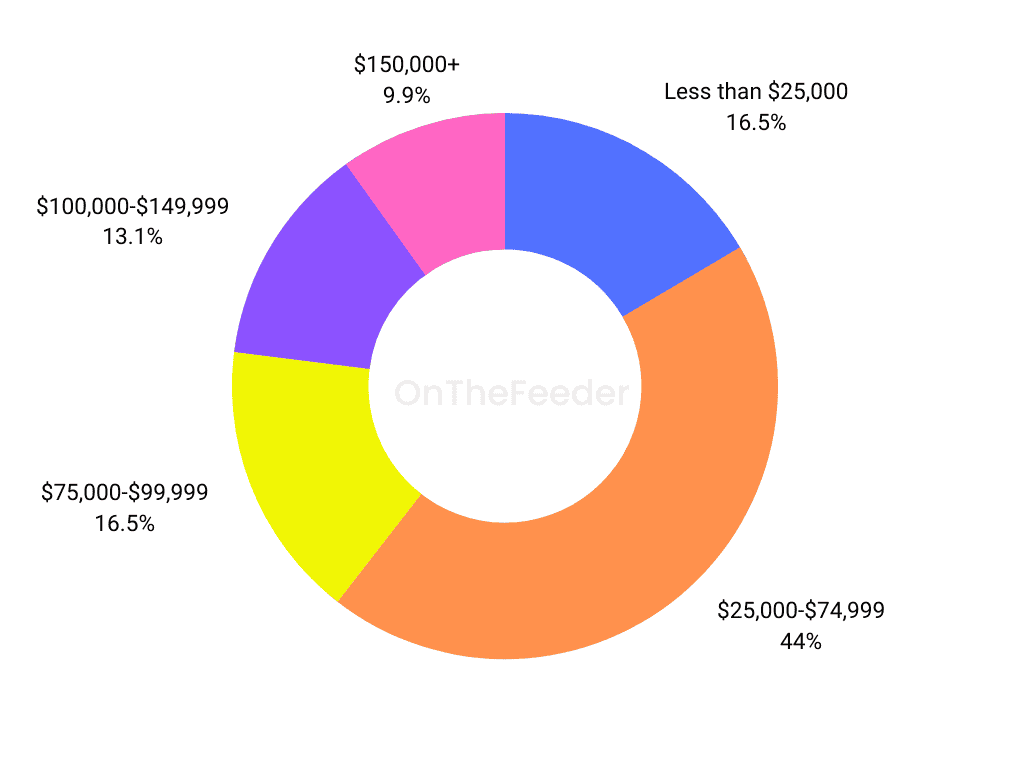
- Income diversity & inclusivity: The diverse range of income levels among birdwatchers suggests that birdwatching is an inclusive hobby that attracts individuals from different socioeconomic backgrounds. It indicates that birdwatching can be enjoyed and pursued by people regardless of their income level.
- Accessibility of the hobby: The presence of birdwatchers across various income categories suggests that birdwatching is accessible to individuals with different financial means. It implies that one’s income does not necessarily determine their ability to engage in birdwatching, highlighting the potential for anyone interested in the hobby to participate.
- Conservation engagement: The income distribution among birdwatchers suggests that both higher-income and lower-income individuals can contribute to bird conservation. Higher-income birdwatchers may offer financial support, while lower-income birdwatchers may contribute through volunteering, advocacy, or local community involvement. This highlights how birdwatching can promote conservation across different income levels.
Birdwatching in the Yard
Q: What percentage of your birdwatching takes place in and around your yard?
The survey results shed light on how often birdwatchers engage in their hobby within their own yards:
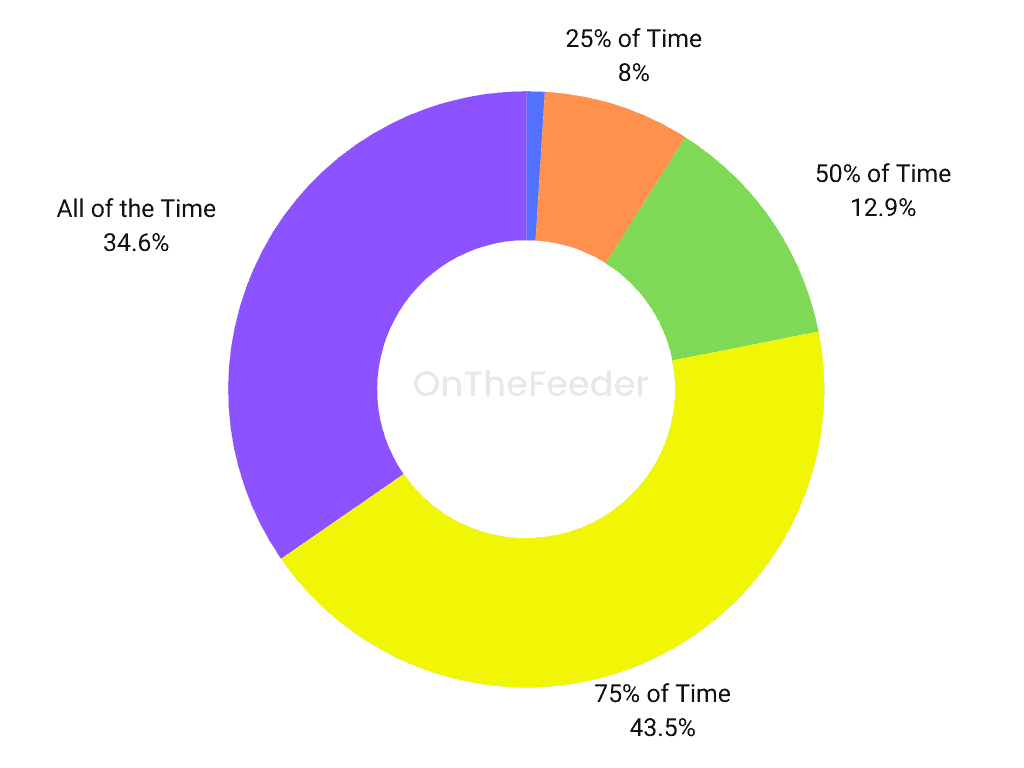
- Dominant Yard Usage: The majority of birdwatchers (43.5%) reported spending 75% of their birdwatching time in their own yard, underscoring the importance of home spaces as birdwatching sites for many enthusiasts.
- Exclusive Yard Watchers: A significant portion of birdwatchers (34.6%) exclusively observe birds in their yard, highlighting their yard as the primary or sole location for their birdwatching activities.
- Non-Yard Watchers: Interestingly, a very small percentage (0.5%) of respondents reported not watching birds in their yards at all. This suggests that for the overwhelming majority of birdwatchers, their yard is a key birdwatching location.
Where Birdwatchers Live
The survey results offer a glimpse into the typical community environments where birdwatchers reside. With no particular definition provided, birdwatchers self-classified themselves as living in a city, suburb, or rural area.
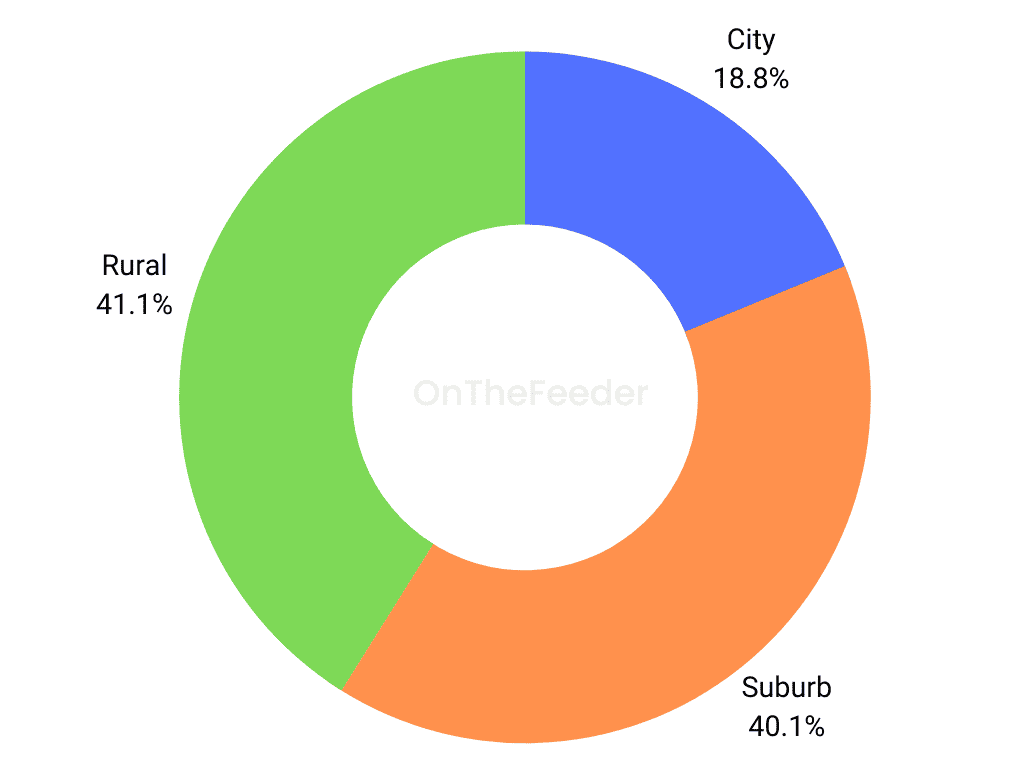
- Rural Living: The largest portion of birdwatchers (41.1%) reported living in a rural area. This implies that a substantial portion of the birdwatching community has direct access to more natural, less populated environments.
- Suburban Living: A close second, 40.1% of birdwatchers described their living environment as a suburb. This suggests that a significant number of birdwatchers live in areas that often combine the convenience of urban amenities with some aspects of nature.
- City Living: A smaller percentage of birdwatchers (18.8%) live in a city. This shows that despite the potential challenges of observing birds in more densely populated areas, city-dwelling individuals still engage in birdwatching.
These insights can help inform strategies for product development, education, and community building in the birdwatching industry by understanding the variety of environments in which birdwatchers live. It also emphasizes the widespread appeal of birdwatching across different types of living environments.
Age When Started Birdwatching
The survey results regarding the age at which people began birdwatching provide the following insights:
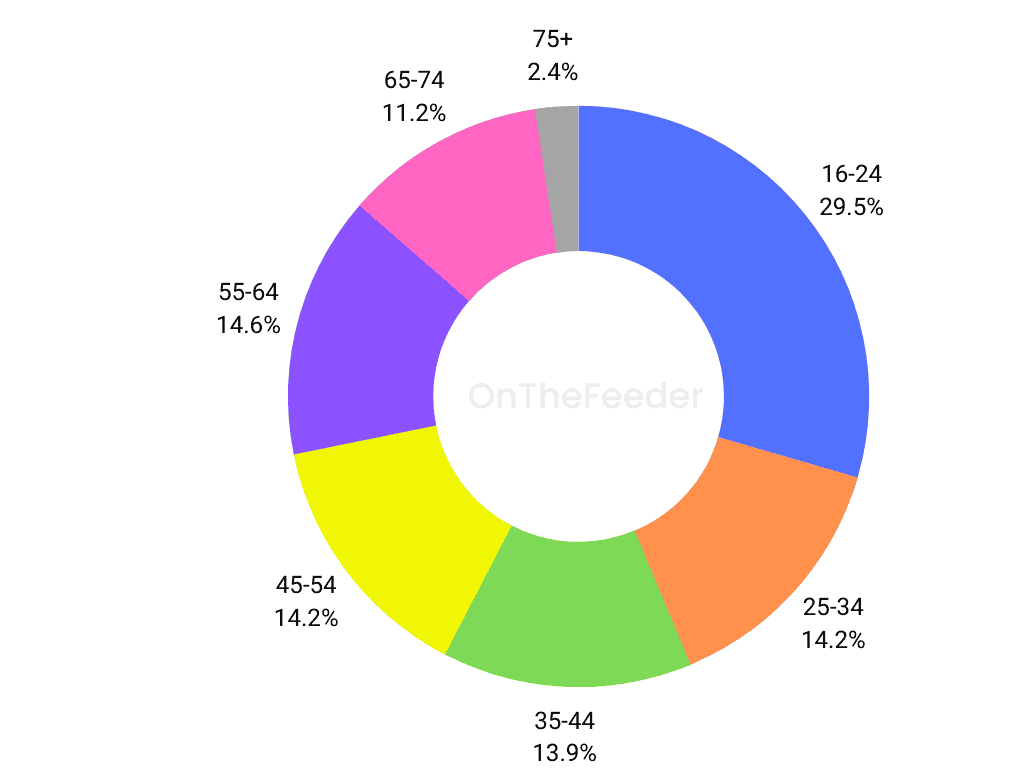
- Early interest among younger individuals: A significant portion of birdwatchers (29.5%) started engaging in birdwatching during their late teens to early twenties (16-24 years old). This suggests that there is a considerable level of interest and curiosity among younger individuals in this hobby.
- Steady engagement across different age groups: The data shows a relatively consistent level of engagement in birdwatching across different age groups, with percentages ranging from 14.2% to 14.6%. This indicates that people of various age ranges, from 25 years old to 64 years old, continue to develop an interest in birdwatching.
- Potential mid-life engagement: The age groups of 35-44 years old and 45-54 years old show notable percentages (13.9% and 14.2%, respectively) of individuals who began birdwatching during those periods. This suggests that birdwatching might attract individuals in their mid-life stages, possibly as a new or additional interest developed during this time.
- Lifelong passion and continued interest: The data also reveals that a significant portion of birdwatchers (11.2%) started birdwatching during the age range of 65-74 years old. Additionally, a small but notable percentage (2.4%) began birdwatching at 75 years or older. This indicates that birdwatching can be a lifelong passion, with individuals discovering and engaging in the hobby later in life.
These insights highlight the diversity of age groups involved in birdwatching, ranging from young enthusiasts to individuals discovering the hobby in their middle age and later stages of life. They showcase the potential for birdwatching to capture interest across various life stages, contributing to the overall engagement and longevity of the birdwatching community
How Birdwatching Experiences Are Shared
The survey results provide insights into the different methods birdwatchers use to share their experiences:
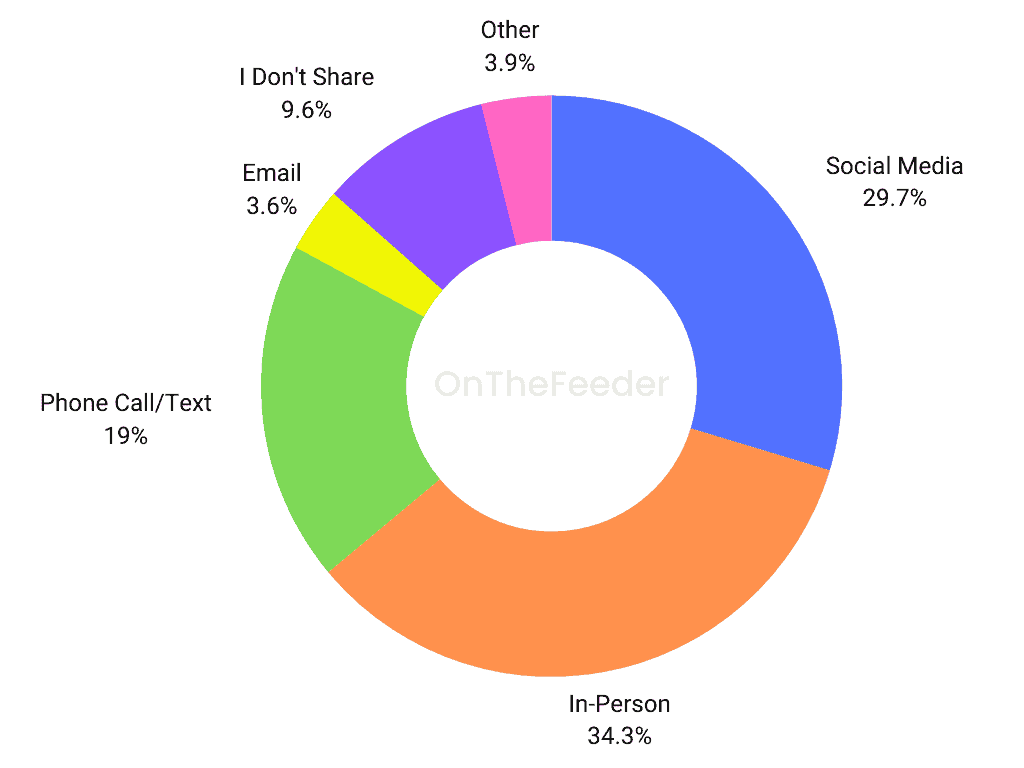
- Social media: A notable percentage (29.75%) of birdwatchers prefer to share their experiences through social media platforms, leveraging the reach and convenience of online platforms to share birdwatching moments.
- In-person: A significant portion (34.3%) of birdwatchers opt for in-person interactions to share their birdwatching experiences, indicating a preference for direct communication and face-to-face conversations.
- Phone communication: A considerable number (19%) of birdwatchers choose to share their experiences using their phones through calls or texts, highlighting the personal and immediate nature of this form of communication.
- Email: A small percentage (3.6%) of birdwatchers utilize email as a means to share their birdwatching experiences, likely opting for a more formal and detailed communication method.
- Non-sharers: The survey results also reveal that a notable portion (9.6%) of birdwatchers do not actively share their birdwatching experiences, suggesting that some individuals prefer to keep their observations and encounters to themselves.
These insights showcase the diverse ways in which birdwatchers choose to share their experiences, ranging from digital platforms to in-person interactions and personal communication methods. Understanding these preferences can inform strategies to enhance communication and community-building within the birdwatching community.
What is the top state for birdwatching?
Ohio is the top state for birdwatching, with 6.7% of U.S. birdwatchers living there.
The survey results offer insights into the geographic distribution of birdwatchers across the remaining 50 states:
| State | % of Birdwatchers Live Here |
|---|---|
| AL | 1.2% |
| AK | 0.0% |
| AZ | 0.4% |
| AR | 1.2% |
| CA | 4.1% |
| CO | 1.6% |
| CT | 0.9% |
| DE | 0.4% |
| FL | 6.6% |
| GA | 5.0% |
| HI | 0.0% |
| ID | 0.9% |
| IL | 4.4% |
| IN | 1.6% |
| IA | 1.8% |
| KS | 0.7% |
| KY | 2.7% |
| LA | 1.1% |
| ME | 1.4% |
| MD | 1.4% |
| MA | 2.7% |
| MI | 3.4% |
| MN | 2.3% |
| MS | 1.1% |
| MO | 1.4% |
| MT | 0.4% |
| NE | 0.7% |
| NV | 0.0% |
| NH | 0.7% |
| NJ | 2.8% |
| NM | 0.2% |
| NY | 5.2% |
| NC | 3.6% |
| ND | 0.0% |
| OH | 6.7% |
| OK | 1.4% |
| OR | 0.7% |
| PA | 3.9% |
| RI | 0.4% |
| SC | 1.8% |
| SD | 0.5% |
| TN | 3.2% |
| TX | 5.7% |
| UT | 0.5% |
| VT | 0.4% |
| VA | 4.8% |
| WA | 2.0% |
| WV | 0.7% |
| WI | 5.3% |
| WY | 0.4% |
- Diverse Geographic Distribution: The birdwatching community is spread across all states, indicating a broad interest in birdwatching throughout the country. This underscores the widespread appeal of birdwatching as a hobby, irrespective of the state or region.
- States with Significant Participation: Some states reported higher percentages of birdwatchers, including Ohio, Florida, Georgia, New York, and Wisconsin, suggesting areas with particularly active birdwatching communities or favorable environments for birdwatching.
- States with Lower Participation: Conversely, a few states had low or no reported birdwatching activity including Alaska, Hawaii, Nevada, and North Dakota. This could be due to various factors, such as population size, environmental conditions, or less awareness or interest in birdwatching in these regions.
These findings provide a snapshot of the geographic diversity within the birdwatching community, which can inform national strategies for promoting birdwatching, conserving bird habitats, and providing relevant resources and support for birdwatchers across the country.
Where is birdwatching most popular?
The top 5 U.S. States in terms of birdwatching popularity are:
- Ohio
- Florida
- Georgia
- New York
- Wisconsin
Biggest Challenges
The survey results delve into the main challenges encountered by birdwatchers during their pursuit of the hobby:
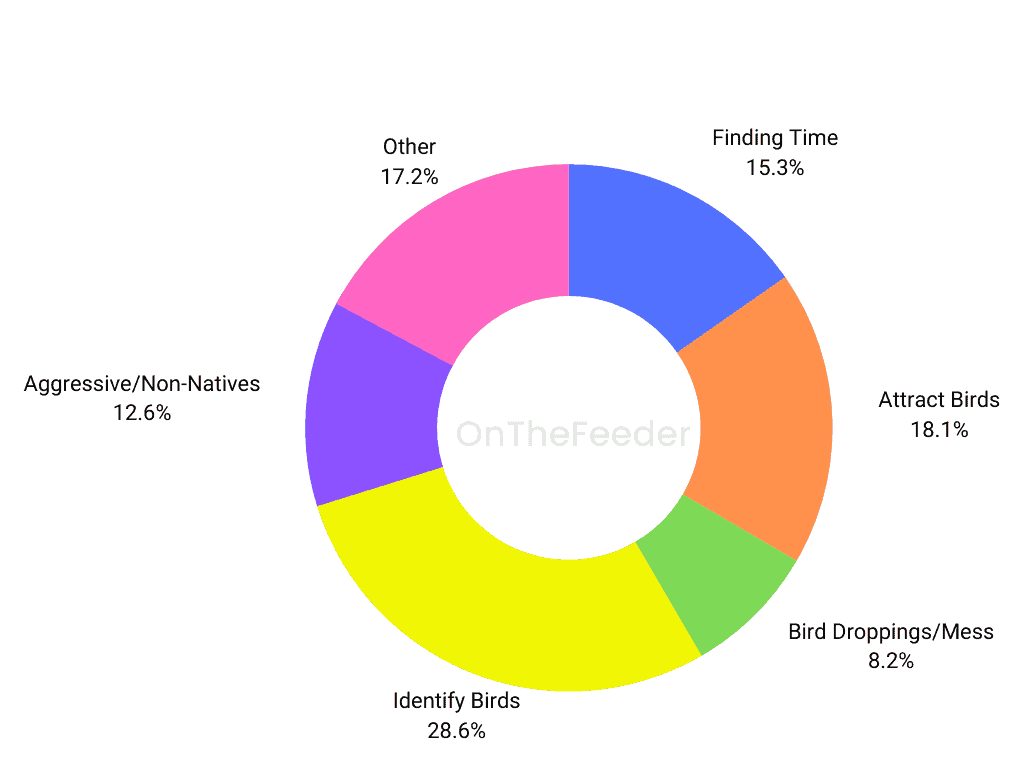
- Accurate Identification: The greatest challenge, reported by 28.6% of respondents, is accurately identifying different bird species. This emphasizes the importance of knowledge and learning in birdwatching, and the difficulties that can arise from the vast diversity of bird species.
- Attracting Birds: Close behind, 18.1% of respondents cite attracting birds to their yard as a primary challenge. This highlights the practical difficulties birdwatchers may encounter when trying to observe birds in their own surroundings.
- Time Constraints: For 15.3% of birdwatchers, the most significant challenge is finding the necessary time to engage in birdwatching. This reflects the balancing act many hobbyists face when juggling their interests with other life commitments.
- Dealing with Aggressive/Non-Native Birds: For 12.6% of respondents, dealing with aggressive and/or non-native birds poses a significant challenge, highlighting an ecological concern within the birdwatching community.
- Dealing with Bird-Related Mess: A smaller group of birdwatchers (8.2%) identified dealing with bird droppings or related mess as a considerable issue. This underlines one of the more practical and less glamorous aspects of the hobby.
Understanding these challenges can offer valuable insights into the birdwatching experience and help shape future support, educational resources, and community initiatives tailored to address these issues.
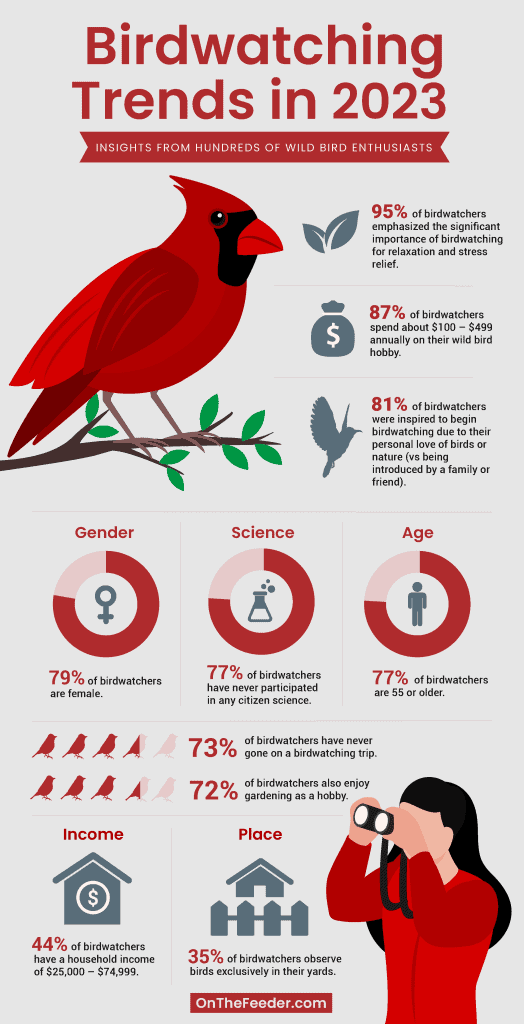
What else could the survey results be telling us?
The Intersection of Age and Relaxation
The data shows that the majority of birdwatchers are older (55 and above), and a significant percentage (95.9%) find birdwatching to be a source of relaxation and stress relief.
This correlation might suggest that birdwatching provides a therapeutic effect for an older population, potentially due to the slower, more relaxed pace of the activity and the connection with nature.
Birdwatching could thus be promoted as an accessible and enjoyable hobby for older individuals looking for ways to relax and reduce stress.
Age Dynamics in Birdwatching
When analyzing the data for the age when people started birdwatching and their current age, the following conclusions can be drawn:
Many people start birdwatching later in life, typically as adults or during their later years. It seems like birdwatching is a hobby that people tend to pick up when they’re older.
Once people get into birdwatching, they tend to stick with it for a long time. Many birdwatchers continue to enjoy the hobby throughout their lives. It’s something that brings them ongoing fascination and joy.
Interestingly, there aren’t as many younger birdwatchers compared to older ones. It seems like there might be some reasons why younger people aren’t getting into birdwatching as much. It could be because they have other interests or aren’t exposed to it as much. To encourage younger generations to give it a try, we should find ways to address these barriers and make birdwatching more accessible.
The age differences within the birdwatching community present an opportunity for different generations to connect. Older birdwatchers can share their knowledge and experiences with younger enthusiasts, creating a sense of community. This way, skills and passion can be passed down and shared, making the birdwatching community more diverse and connected.
The Connection Between Residential Environment and Birdwatching Habits
The data indicates that a large portion of birdwatchers are suburban (40.1%) and rural (34.5%) dwellers. Interestingly, most birdwatchers prefer watching birds in their own yard.
There might be a correlation between residential type and birdwatching habits, suggesting that having access to private outdoor space could increase engagement in birdwatching.
This insight can be used to target birdwatching promotions and products for those living in suburban or rural areas.
Nature-based Interests and Spending Habits
The survey shows that birdwatchers tend to engage in other nature-based hobbies such as gardening, hiking, and photography.
Also, a substantial portion of respondents reported spending $200 or more annually on birdwatching supplies. This could suggest a willingness to invest in activities that bring them closer to nature. It would be worth exploring whether those with other nature-related hobbies are also the ones who tend to spend more on birdwatching supplies.
This data can be utilized to cross-promote products, services, or events that align with these nature-based interests.
Conclusion
This survey of 560 birdwatchers provides an insightful overview of the birdwatching community’s characteristics and interests. It reveals birdwatching as an activity embraced primarily by older individuals and pursued largely for relaxation and stress relief.
The survey suggests that birdwatching holds a wealth of therapeutic value, with nearly 96% of respondents acknowledging its role in fostering relaxation and reducing stress.
The findings also highlight the potential for promoting birdwatching as a wellness activity, catering not only to bird lovers or nature enthusiasts but also to a wider audience seeking effective ways to unwind.
The research additionally uncovers the diverse interests of birdwatchers beyond their feathered friends. Nature-centric hobbies like gardening, photography, hiking, and traveling are prevalent among the respondents, underlining the overarching theme of nature appreciation.
However, it also surfaces some of the challenges faced by birdwatchers, with accurate bird identification and attracting birds to their yard ranking high. Understanding these challenges is crucial in shaping future support and educational resources tailored to birdwatchers’ needs.
The survey also examines the financial commitment of birdwatchers toward their hobby. With the majority falling into mid-range spending categories, it’s clear that most birdwatchers are prepared to invest moderately in their pursuit. A small but substantial group spends less, showcasing birdwatching’s potential as an inexpensive hobby, while a minor portion invests significantly, indicating a demographic highly committed to the hobby. These findings offer a glimpse into birdwatching’s economic aspect, crucial for the industry catering to birdwatchers. Lastly, the results reveal the birdwatching community’s geographic spread, with participants hailing from all states, demonstrating birdwatching’s broad appeal across different regions and living environments.
Can you draw any additional conclusions from this survey? Leave a comment below.


